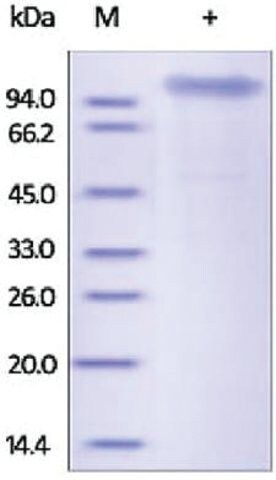您的位置:首页 > 产品中心 > COMP/TSP5 human
COMP/TSP5 human

| 产品编号: | 4117490 |
| 规格: | recombinant, expressed in HEK 293 cells, ≥95% (SDS-PAGE) |
| 包装规格: | 10 μG,50 μG |
| 产品类别: | 进口试剂 |
| 品牌: | Sigma-Aldrich |
| 优惠价: | 立即咨询 |
产品别名
COMP/TSP5 human
EPD1
PSACH
EDM1
THBS5
MED
基本信息
| NACRES | NA.32 |
| General description【一般描述】 | Cartilage oligomeric matrix protein (COMP) also known as Thrombospondin-5 (TSP5), EDM1, EPD1, MED, PSACH, THBS5, which belongs to the thrombospondin family. COMP / TSP5 contain 4 EGF-like domains, 1 TSP C-terminal (TSPC) domain, 8 TSP type-3 repeats. Abundantly expressed in the chondrocyte extracellular matrix, and is also found in bone, tendon, ligament and synovium and blood vessels. COMP may play a role in the structural integrity of cartilage via its interaction with other extracellular matrix proteins such as the collagens and fibronectin. COMP can mediate the interaction of chondrocytes with the cartilage extracellular matrix through interaction with cell surface integrin receptors. Thrombospondin-5 could play a role in the pathogenesis of osteoarthritis. COMP is a marker of cartilage turnover. Cartilage oligomeric matrix protein (COMP), also known as thrombospondin 5 (TSP5), is a key constituent of the extracellular matrix of the musculoskeletal system. It is encoded by the gene mapped to human chromosome 19p13.11. COMP/TSP5 is a fifth member of TSP family. It is a pentameric protein, characterized with an N-terminal coiled- coil oligomerization domain, four type II (EGF-like) domains, eight type III calmodulin like repeats (CLR) and a C-terminal globular domain (CTD). |
| Biochem/physiol Actions【生化/生理作用】 | Cartilage oligomeric matrix protein (COMP) plays a vital role in chondrocyte attachment, differentiation and cartilage extracellular matrix assembly. COMP levels vary in cartilage of osteoarthritis and rheumatoid arthritis patients compared with healthy individuals. Thus, COMP levels in serum and synovial fluid can be used as a biomarker for these diseases. Polymorphism in the gene leads to the development of two autosomal dominant skeletal dysplasias named, pseudoachondroplasia (PSACH) and multiple epiphyseal dysplasia type 1 (MED1). |
| Physical form【外形】 | Lyophilized from 0.22 μm filtered solution in 50 mM Tris, 100 mM NaCl, pH 7.5. Normally Mannitol or Trehalose is added as protectants before lyophilization. |
| Reconstitution【重悬】 | Centrifuge the vial prior to opening. Reconstitute in sterile PBS, pH 7.4 to a concentration of 50 μg/mL. Do not vortex. This solution can be stored at 2-8℃ for up to 1 month. For extended storage, it is recommended to store at -20℃. |
产品性质
| biological source【生物来源】 | human |
| recombinant【重组】 | expressed in HEK 293 cells |
| tag【标签】 | 6-His tagged (C-terminus) |
| Assay【测定】 | ≥95% (SDS-PAGE) |
| form【形式】 | lyophilized |
| potency【效能】 | 1 μg |
| mol wt【分子量】 | calculated mol wt 82 kDa observed mol wt 110-130 kDa (DTT-reduced. Protein migrates due to glycosylation. Gln 21 is the predicted N-terminal.) |
| packaging【包装】 | pkg of 10 and 50 μg |
| impurities【杂质】 | <1 EU/μg endotoxin (LAL test) |
| UniProt accession no.【UniProt登记号】 | P49747 |
| shipped in【运输】 | wet ice |
| storage temp.【储存温度】 | −20℃ |
| Gene Information | human ... COMP(1311) |
安全信息
| Storage Class Code【储存分类代码】 | 11 - Combustible Solids |
| WGK | WGK 3 |




